By Melanie Davidson, VP of Digital Strategy, Merkle

Abandon cart triggers are a critical tool to any retailer’s email program and a known driver for recapturing revenue. Yet, so many retailers still do not take advantage of this critical trigger or if they do, many are sending generic messages. We spend a lot of time analyzing why customers abandon their cart and the data suggests it’s for a variety of reasons — shipping charges, product costs, distraction, lack of inventory and device. I can’t tell you how many times I’ve wanted to purchase something instantly but the experience was so poor on my mobile device I abandon the process all together. With over 60% of retail customers opening their email on a mobile device — it’s critical that the landing and purchase experience is optimized for mobile, a standard process for any email program.
Whether you’ve had an abandon cart program running since your e-Commerce site launched or just launched one, almost every retailer can approach these triggers with more customization and personalization. As marketers become more sophisticated in their abandon cart programs, leveraging why customers abandoned in the first place will be key to maximizing recaptured revenue. For example, triggering a closing offer if someone abandons at check out versus a reminder if someone abandons during cart placement.
The reality is that customers do abandon their carts. However, in the era of big data and increased competition in the inbox, retail marketers need to be smarter about leveraging these triggers and view cart abandonment as an opportunity not a threat. Over 54% of customers abandon their carts and yet, only 19% of the top 1,000 e-Tailers send abandon cart emails. Here are some actionable tips to optimize your Abandon Cart Program, based on the top 5 issues I see both as a marketer and a consumer.
1. Revisit business rules regularly. Business rules are set up with justification and reason; occasionally they can be too strict and eliminate a huge pool of customers. In working with a client recently, we discovered that they did not send an abandon cart trigger if a customer was in the welcome stream. While limiting cadence and frequency make sense — be sure that you are prioritizing what’s going to drive the best customer experience, maximize revenue and business goals. I love J. Crew’s emails and receive and look at them regularly. I have never received an abandon cart email from Jcrew, not sure if that is because they don’t do them or I am eliminated based on some business rule. Marketers can inadvertently limit their ability to recapture revenue when business rules are too strict — these can be easy legacy rules that haven’t evolved as digital programs and access to data has changed over time.
2. Live Test abandon cart program regularly. Testing is critical to any campaign, and when live data is in play, proofing just isn’t enough. Marketers typically have a rigorous proofing process and review send logs and KPIs on a regular basis. It’s equally important to regularly test your abandon cart in a live scenario. This will help to ensure that it’s rendering correctly, data and personalization are populating as it should, and timing, cadence and business rules are working as expected. Here is an abandon cart email I recently received from Neiman Marcus:
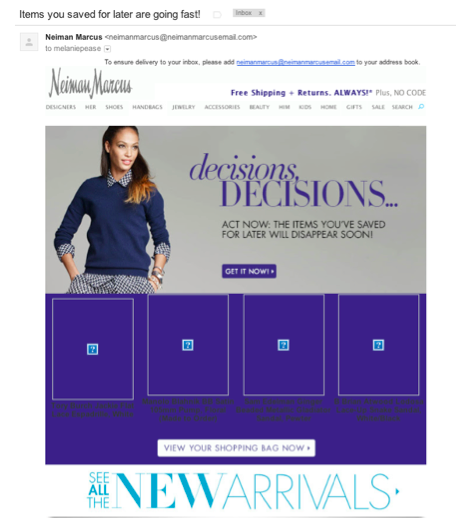
Not only did the images not render in my browser (this wasn’t a “click here” to download pictures issue), the color and font are such a poor mix that it make this email illegible. This is a sub-optimal customer experience that could have easily been avoided or caught if a regular live testing process was in place.
3. Personalize. Despite its maturity as a digital channel, email continues to evolve and enable marketers to take advantage of its unique offerings, personalization itself has evolved beyond use of a customer’s name. Leveraging data and the technology stack allows marketers to not only visually personalize with abandoned product, but also understand where in the process the customer abandoned and how to entice the customer with an added incentive. Did the customer abandon at shipping? Perhaps free shipping is enough of an incentive. Look at the different examples below — Banana Republic’s abandon email is generic and even though they take a crack at offering an incentive — if this isn’t tied to the abandonment reason, free shipping and urgency are likely not enough capture the customer.

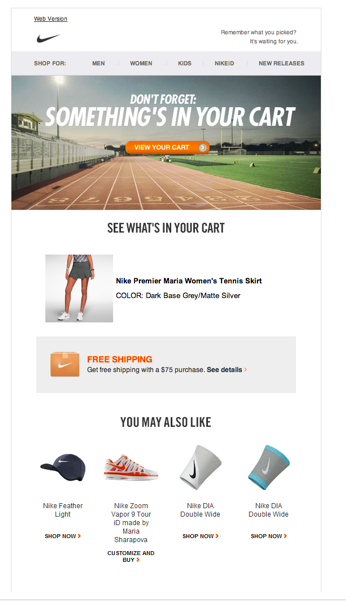
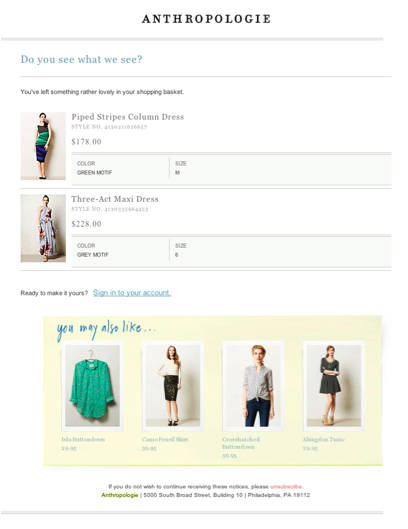
The Antroplogie and Nike examples remind me what I have in my cart. It’s a quick way to visually trigger what I put in my cart in the first place. Yes! I do want that dress. In the Banana Republic example, I have no idea what is in the cart so I must not have wanted it that badly any way — out of sight out of mind.
4. Out of stocks. A common reason customers fail to complete purchase is due to lack of inventory. Nothing is more frustrating than falling in love with an item you must have and it’s not in your size or completely out of stock. On the flip side, receiving an alert that a coveted item is back in stock not only triggers a visual reminder but caters to our sense of urgency: “I’ve got to have it before it runs out again.” Once an item is out of stock, it’s very rare that shoppers will go back to the site on their own and look for it at a later date. Adding out of stock reminders to your abandon cart program is a great way of recapturing revenue. Saks Fifth Avenue does a great job of this. Not only are they leveraging this for revenue recapture, but it’s also a great tool to use to collect an email address — Data gold!
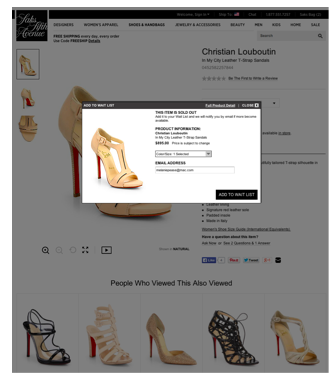

5. Integrate other digital channels. Email is only one way your customers interact with your brand. So a great way to create an integrated digital experience is by leveraging other channels in the digital ecosystem. Email and display can work well together to optimize your abandon cart program. In the era of addressable media and Demand side Platforms (DSP), marketers can leverage the ability to connect known individuals on the web based on cookie and other collected data, layered on, to target their audiences in real time bidding for display ads.
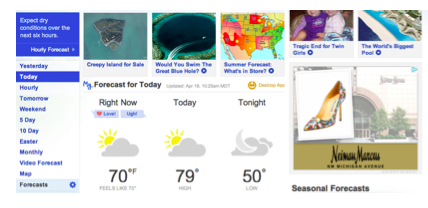
Whether you’ve never sent an abandon cart email or you are sending highly targeted and personalized ones, this should be one of your most valued programs for your ecommerce and retail email program. As more marketers move towards customer centricity, each of your digital programs should embrace customer centricity and personalization in order to build meaningful relationships with individual customers based on their independent needs and wants. When you revisit your Abandon Cart program, look to find better ways to personalize and target your customers based on the point in their purchase cycle at which they abandoned their cart. Also, remember to leverage and integrate other digital channels but do so in a way that creates value for your customer.
Don’t ignore abandonment; it’s a lucrative tool for recapturing revenue while optimizing the customer experience.






